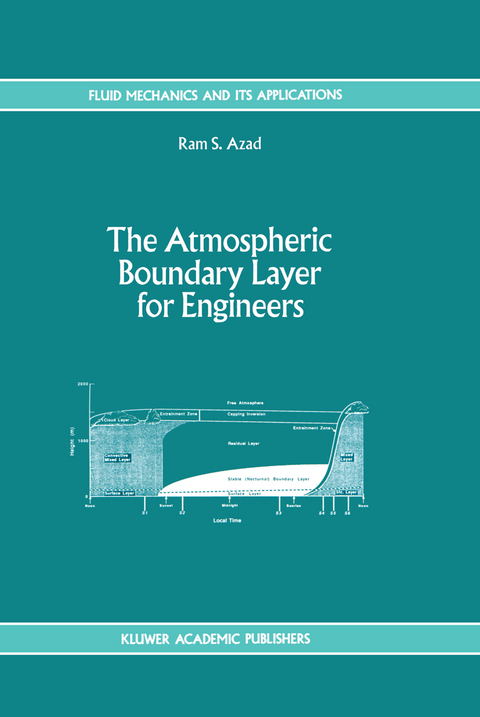
The Atmospheric Boundary Layer for Engineers
Springer (Verlag)
978-0-7923-2187-3 (ISBN)
1. General Description of Atmospheric Boundary Layer.- 1.1 Preliminary.- 1.2 Definition and Significance of the Atmospheric Boundary Layer.- 1.3 The Coriolis Force.- 1.4 Thermal Conditions in Atmosphere.- 1.5 Nature of Flow.- 1.6 Boundary Layer Structure.- 1.7 Micrometeorology.- 2. Thermodynamics of the Atmospheric Boundary Layer.- 2.1 Physical Variables.- 2.2 The Equation of State.- 2.3 Work done by an Expanding Gas.- 2.4 First Law of Thermodynamics.- 2.5 Latent Heats.- 2.6 Adiabatic Processes.- 2.7 Hydrostatic Equilibrium.- 2.8 Moist Air in Atmosphere.- 2.9 Vertical Stability and Convection.- 2.10 The Second Law of Thermodynamics.- 3. Kinematics of Fluid Motion.- 3.1 Equation of Continuity.- 3.2 Acceleration Field of Moving Fluid.- 3.3 Dilatation or Expansion.- 3.4 Reynolds’ Transport Theorem.- 3.5 Dynamic State of Fluid Motion.- 3.6 The Stress Tensor.- 3.7 The Rate of Deformation Tensor.- 3.8 Relationship between $${/hat P_{ik}}$$ and vik.- 3.9 Pik = - P ?ik$${/hat P_{ik}}$$.- 4. Equations Describing Turbulent Motion in the Boundary Layer of the Atmosphere.- 4.1 Equations of Fluid Motion.- 4.2 Momentum Equation in Noninertial Frame of Coordinate System.- 4.3 The Vorticity Equation.- 4.4 The Pressure Equation.- 4.5 Heat Conduction in Fluids.- 4.6 Conservation of Moisture.- 4.7 Turbulence.- 4.8 Equations Governing The Mean Turbulent Field.- 4.9 Equations for Second Moments of Fluctuating Quantities in Turbulent Field.- 5. Dimensional Analysts and Similarity.- 5.1 Introduction.- 5.2 Dimensional Formulae.- 5.3 Nature of the Functional Relations Between Physical Quantities.- 5.4 Procedure for Obtaining a Complete Set of Dimensionless Parameters.- 5.5 Classification of Self-Similarity Solutions.- 5.6 Application of Similarity.- 6. Basics of Usual Turbulent Boundarylayer; Neutrally Stratified Atmospheric Boundary Layer.- 6.1 Introduction.- 6.2 The Reynolds Stress Tensor and Turbulent Heat Flux Density near a Wall.- 6.3 Mean Velocity Profile in Close Proximity to a Rigid Wall.- 6.4 Viscous Sublayer and Logarithmic Boundary Layer in Flow Close to a Smooth Wall.- 6.5 Flow Along a Rough Wall. Roughness Parameter and Displacement Height.- 6.6 Turbulent Boundary Layer on a Flat Plate.- 6.7 Distribution of Concentration of a Passive Admixture Close to a Wall; Mass-and Heat-Transfer in a Turbulent Boundary Layer.- 6.8 General Perception of Viscosity and Thermal Diffusivity.- 6.9 Further Implications of Richardson Number.- 6.10 Use of Semiempirical Equations for the Description of Turbulence in the Planetary Boundary Layer of the Atmosphere.- 7. the Atmospheric Surface Layer.- 7.1 The Atmospheric Surface Layer Modelled by Thermally Stratified Turbulent Boundary Layer.- 7.2 Use of Dimensional Methods to Turbulence in a Stratified Medium.- 7.3 The Structure of the Universal Functions Characterizing Turbulence in a Stratified Medium.- 7.4 Extended Examination of the Universal Functions; Interpolation Formulae and Semiempirical Formulae.- 7.5 General Similarity Hypothesis for a Turbulent Stratified Boundary Layer and its use in Turbulent Fluctuations.- 7.6 Comparison of the Theoretical Results with Experimental Observations.- 7.7 Measurement Techniques for Turbulent Fluxes of Momentum, Heat, and Water Vapour.- 7.8 Acquisition of Turbulent Fluxes from Data on Profiles of Meteorological Variables.- 7.9 Behaviour of Fluctuations of Wind Velocity and Temperature in the Atmospheric Surface Layer.- References.
| Erscheint lt. Verlag | 31.3.1993 |
|---|---|
| Reihe/Serie | Fluid Mechanics and Its Applications ; 17 |
| Zusatzinfo | XVI, 574 p. |
| Verlagsort | Dordrecht |
| Sprache | englisch |
| Maße | 155 x 235 mm |
| Themenwelt | Naturwissenschaften ► Geowissenschaften ► Meteorologie / Klimatologie |
| Technik ► Maschinenbau | |
| ISBN-10 | 0-7923-2187-1 / 0792321871 |
| ISBN-13 | 978-0-7923-2187-3 / 9780792321873 |
| Zustand | Neuware |
| Haben Sie eine Frage zum Produkt? |
aus dem Bereich


